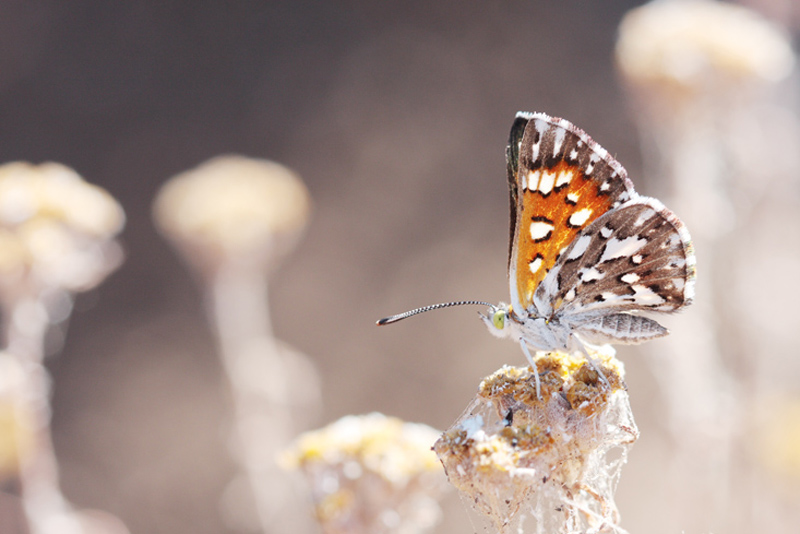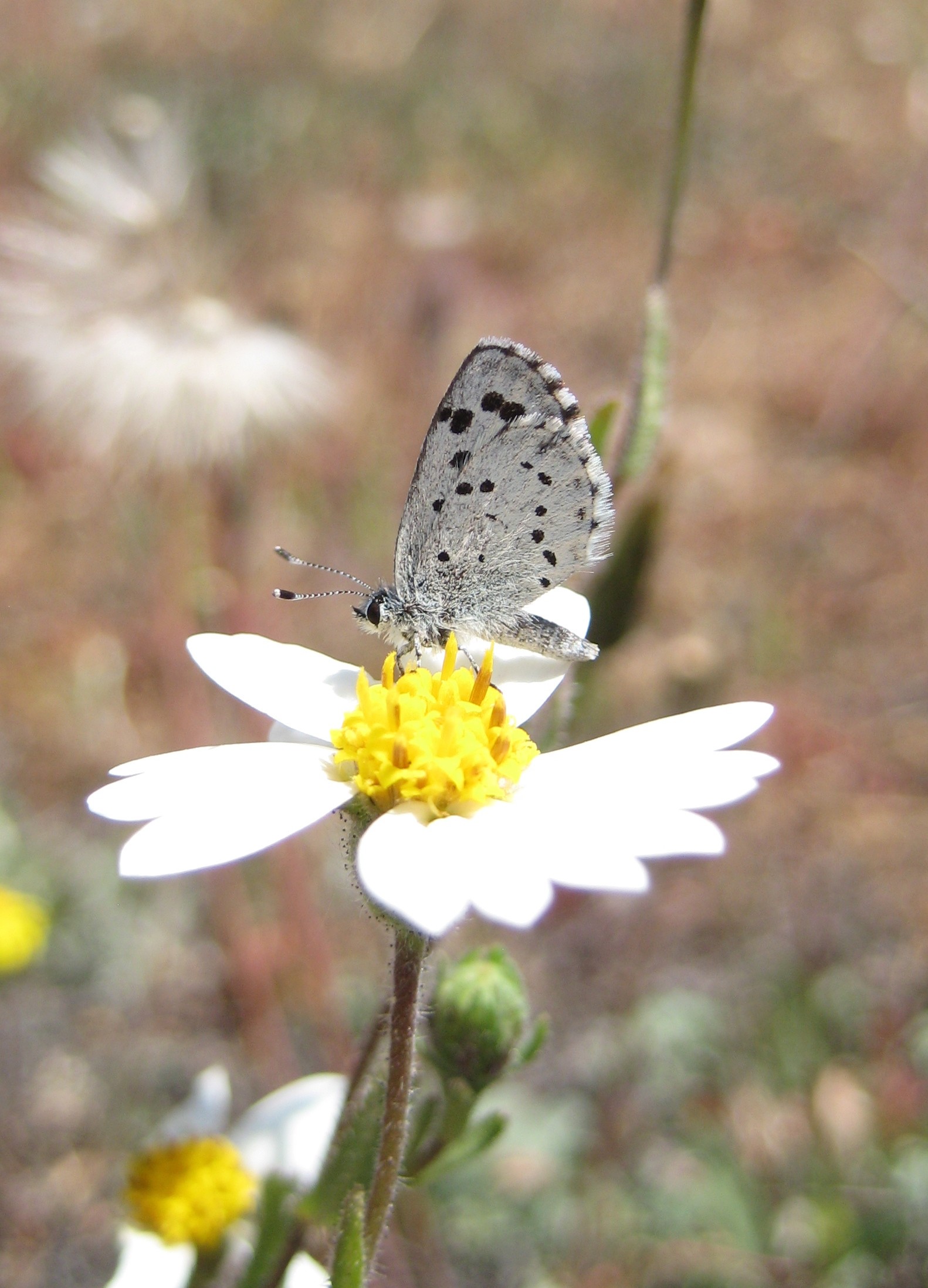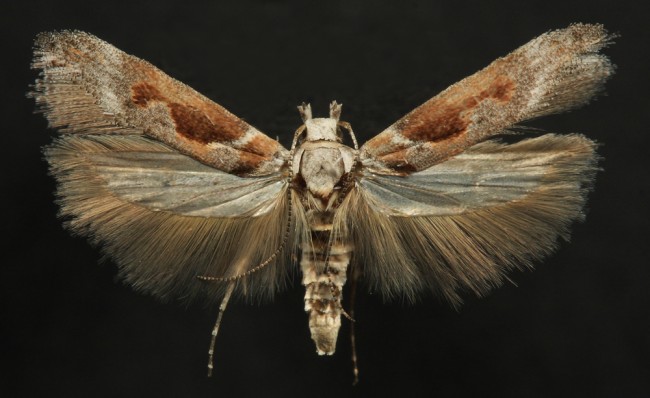Von Chris Grinter, am 24. Februar, 2010

Kennen Sie diese Schmetterling? Es ist in Ordnung, niemand wirklich. Es ist aus der Gattung Apodemia (Riodinidae), aber die Taxonomie dieser Gruppe ist eine Katastrophe… und nicht einmal mir auf die Unterarten zu beginnen. Dieses Exemplar wurde im September fotografiert, was bedeutet, es ist am ehesten Apodemia mormo sein (Mormone) based on flight time. EIN. Mormone is a fall flyer and EIN. virgulti is a spring flyer. While some forms seem distinctive, there is massive morphological overlap and they are usually identical and sympatric – actually down to living on the same plants. But according to lab experiments it is impossible to get the pupae to break diapause so they remain reproductively isolated. So are they different? While molecular work is being conducted the verdict is out, but it does seem like these two species may be retained in the end. Und natürlich, each mountain range has it’s own subspecies. Who knows, I sure don’t. I’m glad I don’t work on butterflies.
Species concepts are a fuzzy line and it’s never clear exactly where to make the cut. When asked what a species is most people default to the Mayr concept of Biological Species (BSC), where reproductive isolation = new. This is all well and good but we have to keep in mind that this is not the ONLY species concept. Es gibt dozens, and not one is perfect. Groups like Grammia (Noctuidae: Arctiinae) exhibit high levels of hybridization, which does not adhere well to the BSC. I like to apply as many criteria as possible to delimit a species and it seems like the line is all too commonly thin within insects. I like to see a distinguishing morphological trait, if not in wing color or pattern, at the least in the genitalia or antennae. This is not always the case however and you have to look at the biology and/or DNA. I have looked at two insects that are for all intents and purposes identical. But the biology is radically different and a large % difference (über 8% – ja, arbitrary) in their DNA makes it unquestionable that they are separate.
And if species weren’t contentious enough subspecies stir the pot even more. I’m skeptical about the entire concept, but there are cases in which it seems plausible and necessary. A subspecies is a more formal definition of a geographical “bilden” and usually exhibits a blend zone into another subspecies. For instance if you look at the 27 different populations of Plebejus icarioides there are large differences between northern and southern populations, but very subtile difference along the gradient. It is that persistent gradient that creates one dynamic species instead of 27 separate species – at least according to current research. Moths have been lucky and have thus far avoided the plague of over-subspeciation, butterflies not so much. There may even be instances where greedy collectors have named new subspecies of Parnassius for profit (new rare butterfly subspecies sell for big bucks).
The truth is that species concepts are artificial, poorly understood and dynamic at best; at worst it approaches a soft science with no real possibility of proof. Yet species are real and theories will continue to adapt while we sit here and scratch our heads.
Von Chris Grinter, am 23. Februar, 2010 

Einer der Vorteile des Seins ein Entomologe ist das Reisen und Sammeln. Ich habe ein paar tausend Meilen auf dem Auto jeden Sommer und das sind zwei der besten Plätze in Arizona zu sammeln. Das obere Bild ist von den Baboquivari Mountains (Baboquivari Spitze in der Mitte), Brown Canyon Forschungsstation. The bottom image is of Pena Blanca Canyon, a famous collecting hotspot. This canyon is just 5 miles from Mexico and has a few safety concerns because of our current immigration policy. One morning, while sorting moths from the previous nights catch, a colleague and I had a group of roughly 30 illegals walk right through our camp. They were well dressed and clean, waved, and must have just been dropped off at the fence. Thankfully the majority of illegals are hard-working and honest people trying to earn a better life. It’s the coyotes and smugglers that are scarier – I have heard tales of Mexican police escorting drug caravans into the US with heavy artillery. And just last year a border patrol agent was stabbed to death by a coyote in this vicinity.
Dankbar, a bunch of strange guys standing around strange lights at nights grants us a wide berth.
(Are these images small enough to load quickly?)
Von Chris Grinter, am 23. Februar, 2010 Obwohl er ziemlich desinteressiert an Schmetterlingen, sie hübsch anzusehen sind. Hier ist ein wirklich tolles Video von einem Kerl, den ich kenne, die in Süd-Kalifornien. Seine Zeitraffer-Videos von Lepidoptera Lebenszyklen sind recht beeindruckend, und diese im besonderen schön ist. Wenn Sie sich über geschnitten 3:00 im, Sie werden Dutzende von Great Purple Hairstreaks sehen (Atlides halesus) aus ihren Puppen hervor, die Farben sind umwerfend. Dieser Schmetterling stammt aus dem Südwesten und Mexiko, und ich muss zugeben, dass ich es liebe, es im Feld zu finden.
[youtube=http://www.youtube.com/watch?v=KyWJlpIchkE]
Von Chris Grinter, am 23. Februar, 2010 Die kurzen Kommentar über Linus Pauling und Vitamin C unter machte mich daran erinnern zunächst das Video gepostet vor eine Weile durch Pharyngula. Kary Mullis Dies ist, der Erfinder der PCR, und Nobelpreisträger. Seine Erfindung im Grunde gemacht DNA-Analyse möglich. Aber wie Pauling, er ist auch ganz und gar Muttern. Wenn Sie die Zeit, mit ihm zu hören Wanderung haben, give it a shot. Aber in kurzer, er bespricht Astrologie, bestreitet die globale Erwärmung und wie AIDS nicht durch HIV verursacht. Ich frage mich, was die Statistiken sind für Genie Wissenschaftler, die ihre Wippe schieben?
[Vimeo 9167379]
Von Chris Grinter, am 22. Februar, 2010 
Dies ist ein altes Bild von mir, so ist es nicht perfekt. Wenn Sie mir sagen, auf Arten diesen Schmetterling Sie ein High-Five zu bekommen. Wenn Sie wissen, die Unterart, Ich werde dir eine neue Packung von senden #3 Edelstahlstifte! Nur andeuten: Es ist aus dem Westen der USA.
Von Chris Grinter, am 22. Februar, 2010 Today I found dies article in NY times health – wirbt die Vorteile der Akupunktur bei Depressionen Erleichterung in schwangeren Frauen verwendet. Ich habe ein paar Probleme mit dem Journalisten, Shirley S. Wang, andernfalls in ihrem Stück, skeptisch zu bleiben. Aber das ist keine Überraschung, so I won’t bother to point out obvious flaws in the media.
I will point out the flaws in the study. Please find the original full text, hier. So after reading this paper I have come to a few conclusions.
1) Very small sample size of 150 patients, only 141 treated.
2) The study is blinded ONLY for the depression scoring, not administration of acupuncture. In fact, their release form states “Participants in one of these two groups will receive acupuncture that focuses on depression symptoms and the other treatment will not.” Makes sense, getting a needle shoved in your skin is easy to notice. So, these “randomized and blinded” participants knew what was coming and assumed that any poking was supposed to help their depression. Ferner, dies (much better) study has shown that simulated acupuncture with toothpicks works just the same. Careful, this is compelling evidence against the validity of acupuncture – not evidence for the usefulness of stimulated “pressure points”. It is a placebo effect.
3) Study assumes validity of “depression specific” und “non-specific” acupuncture. Meaning one method of pin sticking somehow cures depression over another. What is this based on? Oh wait, they say exactly the exhaustive scientific evidence right here: “patterns of disharmony according to the principles of traditional Chinese medicine”. I’m sorry, please, give me modern medicine over 2,000 year old mythical beliefs. How was the average quality of life and life expectancy for an ancient chinese person? Pretty damn horrible, and I’m sure the average life expectancy did not exceed 35 Jahre.
4) Basing depression scores on one administration of the DSM-IV Hamilton Rating Scale. Not being a psychiatrist I can’t speak to the efficacy of these tests. Aber, I will go out on a limb and assume that a stronger baseline for depression should be established before comparing results. The test may be accurate, but why not administer it more than once to reduce noise.
5) Selection of massage as a second control. This is a bad attempt at token skepticism, they even state right off the bat “Massage was conceptualized as a control treatment because, although it improves mood immediately after a session, there is insufficient evidence to support its efficacy as a treatment for depression.” When I design a study I like to look at all known factors that I believe will disprove my hypothesis. Choosing something that you already believe will fail only shows their hand of gross bias.
6) Failure to control for socioeconomic factors. 67% of the participants were white, the majority of which were well-educated. They even go as far as to state in the discussion “Therefore, results might not generalize to specific minority groups that were underrepresented in our sample”. Is it just me, or does this statement negate the entirety of their research? They are freely admitting that acupuncture might not work as well in other minority groups. Why could this be? The only logical and scientific answer is that a placebo effect differs across socioeconomic boundaries. If, Letztendlich, acupuncture was a legitimate medical science, there would be an insignificant difference seen across physiologically identical organisms.
This study is appallingly bad science. These researchers are beginning with the premise that acupuncture works, and searching for data to support their claims. This is exactly opposite of how to conduct real science. Und, our health reporter at the NY Times didn’t even bat an eye. Fail for you Mrs. Wang, and fail to the NY Times.
Von Chris Grinter, am 21. Februar, 2010 Ich liebe Ming Tsai und seine Koch Reich so viel wie die nächsten 3-am TV-Zuschauer. Tatsächlich, his recipes are fantastic and you should make them yourself. Aber ich habe eine seltsame Tendenz, für ihn zu sagen, bemerkte (paraphrasiert) “Sie sollten immer mit organischen, es ist viel besser für Sie”. Das lässt mich ein wenig verwirrt. What exactly does he mean? Ming is well-educated and this is not anything he should be solely responsible for, but he echoes an all too common misconception that organic is actually better. By better I am interpreting this as healthier, which seems to be a logical gap to bridge. So, let’s look at the data.
A recent and comprehensive review published in the American Journal of Clinical Nutrition has largely convinced me of what I was always skeptical of; that organic foods can not actually be healthier for you. In their breakdown they cited 55 studies and came to the conclusion that “there is no evidence of a difference in nutrient quality between organically and conventionally produced foodstuffs”.
So what is the harm? My problem with all of this is that it is based on the naturalistic fallacy, dass “natural” oder “organic” somehow means that the product is safer or healthier. How many times do you see the term “natural” in the store and never give it second thought? If natural things really were safer then traditional Ayurvedic medicines would not be horribly toxic. Afterall, arsenic, lead and mercury are NATURAL – but they are also some of the most toxic compounds known to man. In the end it is 100% marketing.
Taken from another angle Ming Tsai may not be all that incorrect afterall. I do not have all the data in front of me regarding pesticide contamination of foodstuffs, but it is logical to assume the less contaminated the better. Obviously pesticides can be a bad thing, there are mountains of literature to support the damage they can cause. But the jury seems out on exactly how bad, if at all, these minute residues on our foods are. Conventionally grown foods have regulated levels of residues, but even organics are not free of pesticide contamination. So I look at it differently. Our environment benefits from having safer food. Less chemicals are dumped into our waterways, farmers have to battle less with incredibly powerful toxins, und blinky the fish fights to see another day. We should all strive to live sustainably and organic farming does provide us with an edge.
So once again, what is the harm? People who buy organic quite possibly do so based on genuine environmental stewardship. I would also argue that a very high percentage of these people also believe these foods are healthier (anyone have survey data to support this claim?). So in this instance the result is a net positive. Aber, being right for the wrong reasons should never be acceptable. This strikes at the peak of a larger problem that is driven by marketing and zero science. Case in point – Vitamin C as a cold remedy. A study in PLOS medicine has shown there is no indication for efficacy of VitC against the common cold. Go figure, a once believed to be true staple has begun to be picked apart by science and data. Let’s be careful on what bandwagon we jump and why.
Von Chris Grinter, am 21. Februar, 2010 [youtube=http://www.youtube.com/watch?v=zSgiXGELjbc]
Ich genieße dieses Autotuned Sagan, macht mich mit ich war diese beredte. Watch more videos here at the Symphony of Science.
Von Chris Grinter, am 21. Februar, 2010  So, Wie fange ich einen neuen Blog an?? Schwierige Frage, aber vielleicht ist dies ein guter Zeitpunkt, um mit einer lustigen neuen Art anzugeben. Diese Motte wurde letztes Jahr außerhalb von Santa Barbara gesammelt, CA. Die gewaltige Spannweite, bei 15mm, macht es ziemlich groß für eine Gelechiid-Motte. Die Gattung, Gnorimoschema (ausgesprochen nor-a-mosh-ma), scheint weitaus artenreicher zu sein, als derzeit bekannt ist, also kommt diese Kreatur nicht überraschend. Es gibt mir auch die Möglichkeit, mit den Vorteilen des Studiums einer so wunderbar vielfältigen Gruppe von Tieren zu prahlen. Wenn Sie das Glück haben, ein Freund von mir zu sein, werden Sie wahrscheinlich irgendwann Ihre eigene Spezies bekommen. So, Wie fange ich einen neuen Blog an?? Schwierige Frage, aber vielleicht ist dies ein guter Zeitpunkt, um mit einer lustigen neuen Art anzugeben. Diese Motte wurde letztes Jahr außerhalb von Santa Barbara gesammelt, CA. Die gewaltige Spannweite, bei 15mm, macht es ziemlich groß für eine Gelechiid-Motte. Die Gattung, Gnorimoschema (ausgesprochen nor-a-mosh-ma), scheint weitaus artenreicher zu sein, als derzeit bekannt ist, also kommt diese Kreatur nicht überraschend. Es gibt mir auch die Möglichkeit, mit den Vorteilen des Studiums einer so wunderbar vielfältigen Gruppe von Tieren zu prahlen. Wenn Sie das Glück haben, ein Freund von mir zu sein, werden Sie wahrscheinlich irgendwann Ihre eigene Spezies bekommen.
Andererseits, auch das verdeutlicht das Problem – fast nichts über die vielfältigste Tiergruppe auf unserem Planeten wissen. Was passiert, wenn eine neue Ernte von einem Winzling gefressen wird, unscheinbar, Motte? Rufen Sie einen der Dutzend Menschen auf der Welt an, die Ihnen vielleicht helfen können. Vielleicht wissen sie, was es ist, aber wahrscheinlich ist nichts über seine Biologie bekannt. Dies ist, was in passiert ist Süddakota vor kurzem, als Biokraftstoff-Pflanzen zuletzt von einer Motte gefressen wurden 1910. Was für ein perfekter Grund für mehr Geld! Höchstwahrscheinlich wird meine neue Motte oben nie zu einem Schädling explodieren. Aber Grundkenntnisse über die Arten zu haben, die diese Erde mit uns teilen, ist ein Schritt in die richtige Richtung.
|
Skepsis
|





